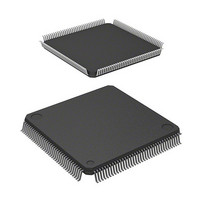R5F61665N50FPV Renesas Electronics America, R5F61665N50FPV Datasheet - Page 441

R5F61665N50FPV
Manufacturer Part Number
R5F61665N50FPV
Description
MCU FLASH 512K ROM 144-LQFP
Manufacturer
Renesas Electronics America
Series
H8® H8SX/1600r
Datasheet
1.R5F61665N50FPV.pdf
(1492 pages)
Specifications of R5F61665N50FPV
Core Processor
H8SX
Core Size
16/32-Bit
Speed
50MHz
Connectivity
EBI/EMI, I²C, IrDA, SCI, SmartCard, USB
Peripherals
DMA, LVD, POR, PWM, WDT
Number Of I /o
92
Program Memory Size
512KB (512K x 8)
Program Memory Type
FLASH
Ram Size
40K x 8
Voltage - Supply (vcc/vdd)
3 V ~ 3.6 V
Data Converters
A/D 8x10b; D/A 2x8b
Oscillator Type
External
Operating Temperature
-20°C ~ 75°C
Package / Case
144-LQFP
Lead Free Status / RoHS Status
Lead free / RoHS Compliant
Eeprom Size
-
Available stocks
Company
Part Number
Manufacturer
Quantity
Price
Company:
Part Number:
R5F61665N50FPV
Manufacturer:
Renesas Electronics America
Quantity:
10 000
- Current page: 441 of 1492
- Download datasheet (8Mb)
10.5.3
The DMAC is activated by an auto request, an on-chip module interrupt, and an external request.
The activation source is specified by bits DTF1 and DTF0 in DMDR.
(1)
The auto request activation is used when a transfer request from an external device or an on-chip
peripheral module is not generated such as a transfer between memory and memory or between
memory and an on-chip peripheral module which does not request a transfer. A transfer request is
automatically generated inside the DMAC. In auto request activation, setting the DTE bit in
DMDR starts a transfer. The bus mode can be selected from cycle stealing and burst modes.
(2)
An interrupt request from an on-chip peripheral module (on-chip peripheral module interrupt) is
used as a transfer request. When a DMA transfer is enabled (DTE = 1), the DMA transfer is
started by an on-chip module interrupt.
The activation source of the on-chip module interrupt is selected by the DMA module request
select register (DMRSR). The activation sources are specified to the individual channels. Table
10.5 is a list of on-chip module interrupts for the DMAC. The interrupt request selected as the
activation source can generate an interrupt request simultaneously to the CPU or DTC. For details,
refer to section 7, Interrupt Controller.
The DMAC receives interrupt requests by on-chip peripheral modules independent of the interrupt
controller. Therefore, the DMAC is not affected by priority given in the interrupt controller.
When the DMAC is activated while DTA = 1, the interrupt request flag is automatically cleared by
a DMA transfer. If multiple channels use a single transfer request as an activation source, when
the channel having priority is activated, the interrupt request flag is cleared. In this case, other
channels may not be activated because the transfer request is not held in the DMAC.
When the DMAC is activated while DTA = 0, the interrupt request flag is not cleared by the
DMAC and should be cleared by the CPU or DTC transfer.
When an activation source is selected while DTE = 0, the activation source does not request a
transfer to the DMAC. It requests an interrupt to the CPU or DTC.
In addition, make sure that an interrupt request flag as an on-chip module interrupt source is
cleared to 0 before writing 1 to the DTE bit.
Activation by Auto Request
Activation by On-Chip Module Interrupt
Activation Sources
Rev. 2.00 Oct. 21, 2009 Page 407 of 1454
Section 10 DMA Controller (DMAC)
REJ09B0498-0200
Related parts for R5F61665N50FPV
Image
Part Number
Description
Manufacturer
Datasheet
Request
R

Part Number:
Description:
KIT STARTER FOR M16C/29
Manufacturer:
Renesas Electronics America
Datasheet:

Part Number:
Description:
KIT STARTER FOR R8C/2D
Manufacturer:
Renesas Electronics America
Datasheet:

Part Number:
Description:
R0K33062P STARTER KIT
Manufacturer:
Renesas Electronics America
Datasheet:

Part Number:
Description:
KIT STARTER FOR R8C/23 E8A
Manufacturer:
Renesas Electronics America
Datasheet:

Part Number:
Description:
KIT STARTER FOR R8C/25
Manufacturer:
Renesas Electronics America
Datasheet:

Part Number:
Description:
KIT STARTER H8S2456 SHARPE DSPLY
Manufacturer:
Renesas Electronics America
Datasheet:

Part Number:
Description:
KIT STARTER FOR R8C38C
Manufacturer:
Renesas Electronics America
Datasheet:

Part Number:
Description:
KIT STARTER FOR R8C35C
Manufacturer:
Renesas Electronics America
Datasheet:

Part Number:
Description:
KIT STARTER FOR R8CL3AC+LCD APPS
Manufacturer:
Renesas Electronics America
Datasheet:

Part Number:
Description:
KIT STARTER FOR RX610
Manufacturer:
Renesas Electronics America
Datasheet:

Part Number:
Description:
KIT STARTER FOR R32C/118
Manufacturer:
Renesas Electronics America
Datasheet:

Part Number:
Description:
KIT DEV RSK-R8C/26-29
Manufacturer:
Renesas Electronics America
Datasheet:

Part Number:
Description:
KIT STARTER FOR SH7124
Manufacturer:
Renesas Electronics America
Datasheet:

Part Number:
Description:
KIT STARTER FOR H8SX/1622
Manufacturer:
Renesas Electronics America
Datasheet:

Part Number:
Description:
KIT DEV FOR SH7203
Manufacturer:
Renesas Electronics America
Datasheet:











